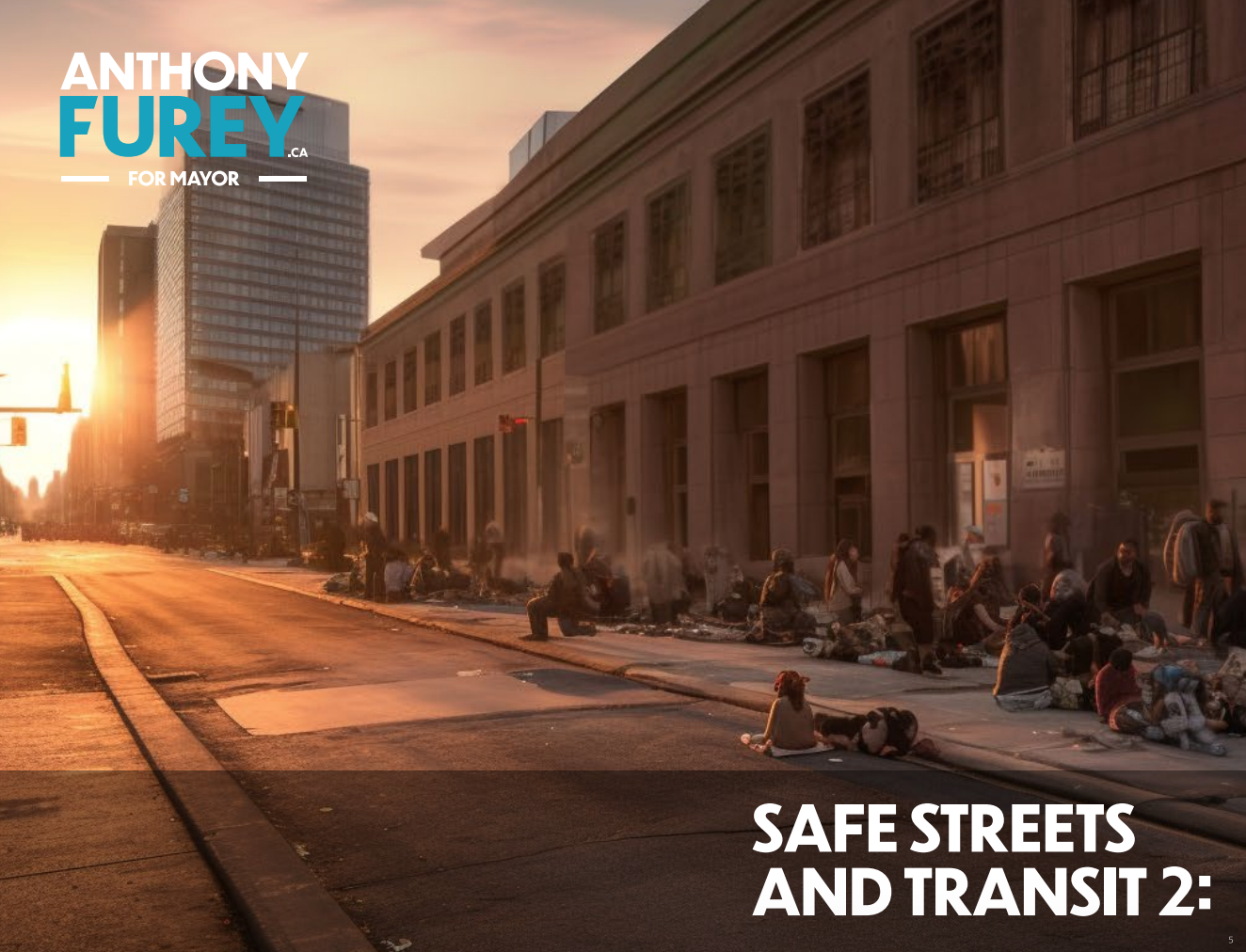Anthony Furey, a former Toronto Sun columnist, is running to be the mayor of Toronto in the June 26 election. Furey has a conservative platform that calls for increased police at tent encampments, dismantling bike lanes, scrapping a harm reduction program offering clean crack pipes to drug users, and adding 500 police officers. While his platform does not mention any stance on the ethical use of artificial intelligence, his campaign appears to have used AI to create fake images of unhoused people on the streets of Toronto to make his pitch.
The Anthony Furey For Mayor campaign platform features multiple images that have hallmarks of AI image generation throughout. For example, one image depicts a hazy, twilight scene as crowds of apparently unhoused people with blurry faces and oddly contorting bodies all sit, stand, or kneel near the exterior of a nondescript two-story building. In some parts of the image specters are outlined, as if the generator could not decide whether there should be a person there or not. The top half of one person’s body appears to be fading out of existence.
Videos by VICE

Other images have odd shapes, abnormalities, and lighting that appear to be AI-generated. An image purporting to show a tent encampment shows an idyllic scene with tents nicely spaced out on green grass—looking more like a music festival than a real encampment in Toronto’s Trinity Bellwoods park—and details further in the background of the image are a loopy jumble typical of AI.

Furey’s campaign is mostly framed around quality of life issues, but he is very angry about bike lanes, which he says are causing congestion and hurting small businesses. (A 2017 study showed bike lanes in Toronto increased customers to businesses.) On homelessness, which he calls a “blight,” Furey wants to forcefully remove tent encampments, saying, “the encampments that have taken over too many of our parks must not be allowed to continue.” His platform does not mention any way to help people access permanent housing—the best way to reduce unsheltered homelessness—but does propose increasing police patrols.
The Furey campaign did not return Motherboard’s request for comment, but it has updated its platform to edit out the most glaring example of AI use.
Initially, a section titled “CREATING JOBS AND RENEWED PROSPERITY” contained an image where a man and a woman sit next to each other, facing an unseen third person. With a notebook and pen on the desk in front of them, they are deep in thought about a serious matter, both with their arms crossed. But the woman has a flannel-clad third arm jutting up from under her armpit and resting on the bottom of her chin. While this seems to be the least of her problems, the arm is not even clothed in the same pattern as her other two arms. The man, not to be outdone, seems at first to be merely folding his arms with his left hand resting on his right bicep, but both sleeves are simultaneously connecting, which means he either has the wrong number of arms or is wearing a very unusual outfit.

The image that replaced the one with three arms also has the hallmarks of AI, featuring a woman’s hair morphing into a necklace among other artifacts.

That Furey’s campaign likely used a prompt-based image generator to illustrate its campaign literature is not in itself shocking; candidates across the world have embraced this dubious approach in the past year, fueling criticisms that AI is being used to spread misinformation and generally warp people’s perception of reality.
What is startling about the images in Furey’s platform is that they contain mistakes so egregious and easy to spot that it makes one wonder how no one caught the issues, or if, alternatively, Furey believes the typical Toronto resident does in fact have three arms.
An increasing number of political figures, particularly on the political right have been using generative AI images in campaigns. Florida governor and Republican presidential candidate Ron Desantis released what look like AI-generated images of his competition, former president Donald Trump, hugging former chief medical advisor Anthony Fauci. The Trump campaign had weeks earlier released a video mocking Desantis’ wobbly twitter spaces campaign launch using AI-generated voices.
The use of AI in political campaigning has resulted in calls to reign it in. On May 2, U.S. Congresswoman Yvette Clarke introduced legislation in the House of Representatives that would require candidates to disclose when they use AI in their campaigns. On May 15, U.S. Senators Amy Klobuchar, Cory Booker and Michael Bennett introduced a version of the legislation in the senate.
In New Zealand, the National Party took heat last month for using AI-generated images in campaign ads meant to stoke fear about the Labour Party depicting thieves ransacking a store, smiling nurses and a woman looking fearfully out the window.
Furey has been gaining ground in mayoral polls and is in fifth place, according to Liaison Strategies. (Another poll showed him in third place on June 9.) Across polls, the lead candidate is still former Toronto Councilmember Olivia Chow.




